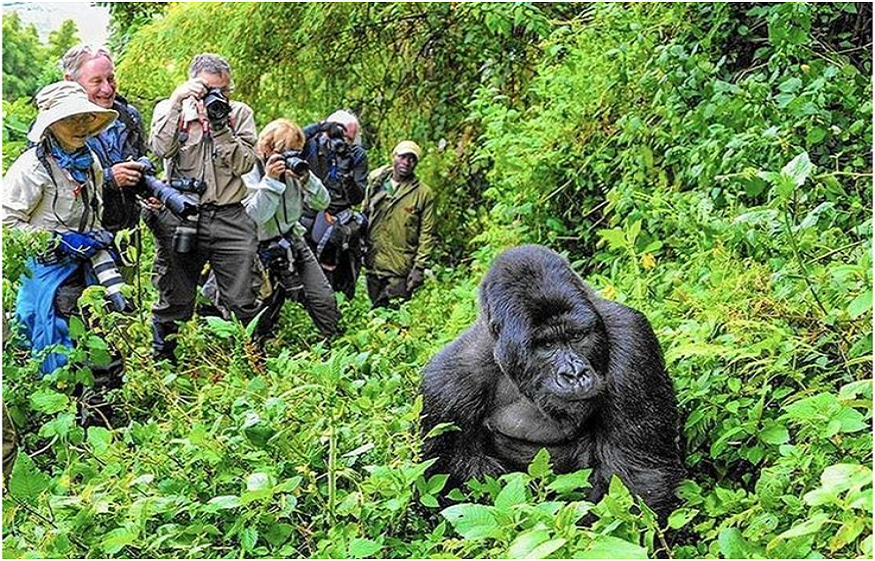When it comes to awe-inspiring wildlife experiences, few encounters can match the sheer grandness of assembling Uganda’s gorillas in their normal living space. These delicate mammoths, with their amazing estimate and momentous insights, have captured the hearts of wildlife devotees and preservationists alike. In this article, we are going set out on a travel through the lavish rainforests of Uganda to find the world of these wonderful animals. From their captivating behaviors to the preservation endeavors committed to their survival, this article will give you a comprehensive knowledge of the world of Uganda gorillas.
The Differing Species of Gorillas
Mountain Gorillas: The Celebrities of Uganda’s Wildernesses
Uganda is domestic to half of the world’s mountain gorillas. Gorilla trekking may be a well-known visitor movement in Uganda, and it may be a once-in-a-lifetime opportunity to see these astounding animals up near. You must follow the rules and directions set by the Uganda Wildlife Authority when going gorilla trekking. Grants are constrained and can be offered out rapidly, so book yours well in progress. The finest time to go gorilla trekking is amid the dry season, from December to February and June to September. You may have to be in great physical condition and dress fittingly for the climate. Be beyond any doubt to pack a bounty of water and snacks.
Here are some things to be beyond any doubt when arranging your gorilla trekking trip to Uganda:
- The leading time to go is amid the dry season, from December to February and June to September.
- You may have to be in great physical condition.
- Dress suitably for the climate.
- Bring a bounty of water and snacks.
Uganda Gorillas: A Lesser-Known Treasure
Uganda gorillas are the greatest of the four gorilla subspecies. They are found inside the east-central African rainforests, from Uganda to the Impartial Republic of the Congo. There are two species of Uganda gorillas: the mountain gorilla and the Uganda marsh gorilla.
- Uganda marsh gorilla: Is found within the woodlands of the Uganda Equitable Republic of the Congo and western Uganda. There are around 3,800 Uganda swamp gorillas cleared out within the wild. They are imperiled due to living space misfortune, poaching, and infection.
- Mountain gorilla: Is found within the Virunga Mountains, which straddle the borders of Uganda, Rwanda, and the Equitable Republic of the Congo. There are as it were around 880 mountain gorillas cleared out within the wild. They are imperiled due to territory misfortune, poaching, and infection.
Gorilla Trekking: An Experience of a Lifetime
Permits and Regulations
To set out on a gorilla trekking enterprise, travelers must get licenses from the Uganda Wildlife Specialist. These licenses not as it were offer assistance in controlling tourism but also contribute to the preservation of these surprising animals. It’s fundamental to book your licenses well in progress, as they are in tall request.
The Trekking Experience
Gorilla trekking isn’t for the blackout of the heart. The enterprise includes climbing through thick timberlands, regularly in challenging landscapes. In any case, the minute you come face-to-face with a gorilla family in the wild, the exertion gets to be beneficial. The feeling of connection with these delicate monsters is nothing brief or mysterious.
Conservation Efforts
The Part of Ecotourism
Gorilla tourism has been a major driver of preservation endeavors in Uganda. The income produced from gorilla trekking grants is utilized to support stop administration, anti-poaching exercises, and community improvement ventures. This has made a difference in decreasing dangers to gorillas, such as environmental misfortune and poaching. It has also made a difference in moving forward the jobs of neighborhood communities, which are presently stronger in preservation endeavors.
Here are a few of the particular ways in which gorilla tourism has profited from conservation:
- It has made a difference to raise mindfulness of the predicament of mountain gorillas and the significance of preservation.
- It has given subsidizing to stop administration and anti-poaching activities.
- It has made a difference to diminish human-wildlife strife.
- It has created occupations and openings for neighborhood communities.
- It has helped to progress the understanding of mountain gorillas and their behavior.
Gorilla tourism may be a win-win for both gorillas and individuals. It may be a maintainable way to produce wages for conservation and advancement, whereas moreover giving sightseers an interesting and exceptional encounter.
Anti-Poaching Initiatives
Despite their protected status, gorillas still confront dangers from poaching and territory misfortune. Preservation organizations and government organizations in Uganda are effectively included in anti-poaching endeavors, utilizing rangers to safeguard these radiant creatures around the clock.
The Ethical Dilemma: Balancing Tourism and Conservation
Gorilla tourism may be a complex issue with both positive and negative impacts. It is imperative to strike the right adjustment between tourism and preservation. The UWA is working to play down the effect of tourism on gorillas and to guarantee that nearby communities benefit from tourism.
A few ethical issues to consider include:
- The effect of human nearness on the gorillas’ behavior and stress levels.
- The chance of malady transmission from people to gorillas.
- The potential for sightseers to disturb the gorillas’ natural behavior.
The UWA has put in put measures to play down the effect of tourism, such as constraining the number of visitors and requiring them to remain at slightest 7 meters absent from the gorillas. We can ensure that gorilla tourism may be a feasible way to preserve these astounding animals by observing the effect of tourism and making alterations as required.
Conclusion
In Uganda, gorilla experiences are not around seeing nature’s splendor; they are almost understanding the fragile adjustment between humankind and the characteristic world. These delicate mammoths remind us of our responsibility to protect them blowing biodiversity that graces our planet.

